How Have Art Museums Been Impacted by Climate Change?
Introduction
With climate change increasingly destabilizing environments, art museums find themselves in a highly precarious position, as they serve as a physical site for visitors, maintain their collections in perpetuity for future generations, and adapt their own practices to environmental sustainability standards.[1] Ithaka S+R’s 2022 Art Museum Director Survey report, funded by the Kress Foundation and the Mellon Foundation, documents art museum leaders’ perspectives and strategies across a range of issues, including how museums are impacted by and planning for climate change.[2] We analyzed short-answer responses from directors to reveal how plans to address climate change are taking shape in museums’ organizational strategies. What did we learn?
Facilities are under threat.
- Thirty-five percent of respondents reported that their museums have experienced damage from climate change. Directors at these museums report that extreme weather, fluctuating temperatures, flooding, and fires mean constantly updating and maintaining facilities to ensure the safety of their staff, visitors, and collections.
Preparation levels vary.
- While half of museums have prepared for climate related damages, half of the directors in our survey population have not. This varies based on geography and museum type, with a lower percentage of directors at academic and Midwestern museums reporting that their museums had created plans for climate related damage.
Many directors have evaluated the impact of their museums on climate change.
- More than two-thirds of directors said their museum has evaluated its climate impact with respect to building operations. However, 18 percent are unsure where to even begin such an evaluation.
Experience and Impact
Overall, 63 museum directors report that their institutions have experienced challenges and damage related to climate change, representing just over a third of all directors that participated in the survey. This was reported by directors in the West (47 percent) and South (44 percent) more frequently than in the Northeast (35 percent) and Midwest (10 percent) regions of the US. Flooding, extreme temperatures, and extreme weather (such as hurricanes, tornadoes, and storms) were the most commonly listed experiences, as seen in Figure 1. These responses, coupled with other recent research, suggest that water damage from flooding, storms, and rising tides is one of the most persistent threats to museums in the US.[3]
Figure 1: Museums’ Experiences with Climate Change Related Events
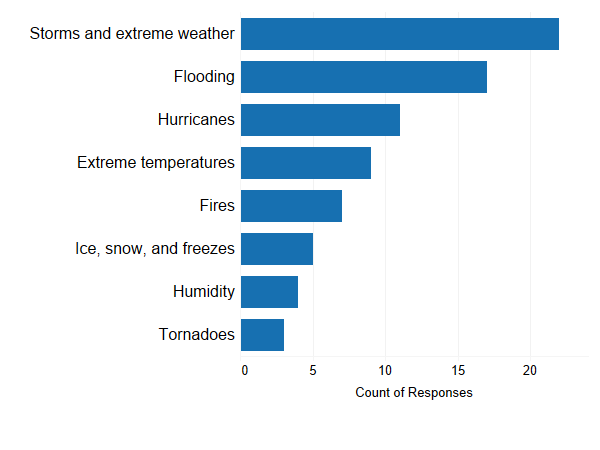
In their responses, directors also described how their museum’s buildings, grounds, or gardens had been affected (Figure 2).
Figure 2: Challenges and Damages from Climate Change Related Events
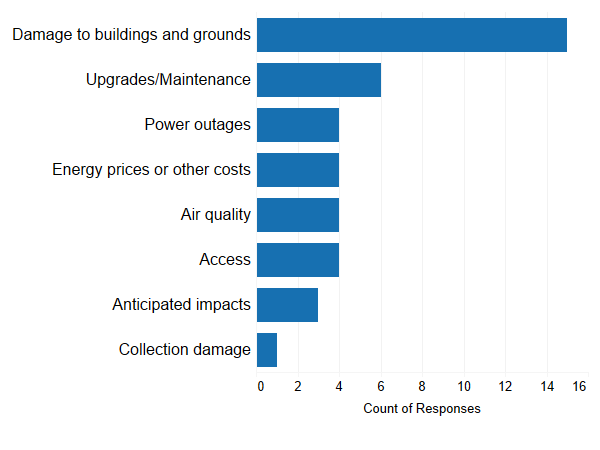
These impacts, including water damage from flooding and poor air quality from wildfires, create unsafe environments for employees and visitors as well as threaten the preservation of collections. The increasing frequency and severity of temperature fluctuations, storms, and natural disasters has intensified the maintenance required for existing infrastructure and internal climate control systems. As one director explained, “The need to maintain and replace our aging systems (boilers) and infrastructure not only saps money away from programs but endangers the objects and the staff who work in the museum.” Another director told us that “water mitigation seems to be a more or less constant issue.”
The need to maintain and replace our aging systems and infrastructure not only saps money away from programs but endangers the objects and the staff who work in the museum.
Addressing Climate Change in Organizational Strategy
How prepared are museums for navigating future impacts of climate change? Fifty percent of directors reported that their museum had begun planning for climate change disasters. Most directors shared that their museum had a general emergency or disaster response plan that addressed potential climate change impacts, while others referred to specific weather event planning (for example, snow storm plans), recent changes to their buildings or infrastructure, or said they were currently working on or revising their plans (Figure 3).
Figure 3: How Museums are Planning for Climate Related Disasters
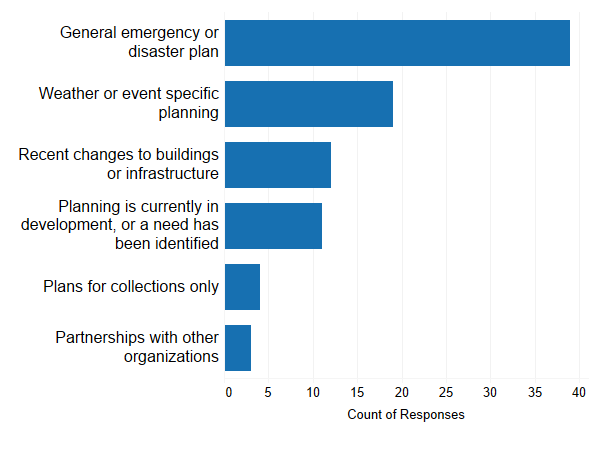
Planning for changing environments and possible disasters varied by region; more directors in the South (62 percent), Northeast (54 percent), and West (53 percent) told us their museum had begun planning than directors in the Midwest (25 percent). This planning process may also vary for institutions with different organizational structures. For example, 59 percent of municipal museums said their museum had planned for climate related disasters compared to 40 percent of academic museums, for whom this kind of planning might instead take place at the college or university level. While availability of funding, staffing, and expertise will no doubt impact how museums are able to respond to and prepare for these challenges, responses were similar across budget levels.
Museum directors also reported if and how their museums had identified ways to support their local communities in the event of a climate disaster, such as the Museo de Arte de Ponce’s community support in the wake of hurricane Maria and the earthquake of 2019.[4] Only 14 directors, about eight percent of respondents, said that their museum had done so, and in these cases it is most commonly through provision of shelter or services (Figure 4). These services include collecting and distributing supplies and providing a food pantry. Other examples, including free admission to air-conditioned spaces on high-heat days and backup generators that supply power, are relatively low barrier ways for museums to consider how they might provide community support.
Figure 4: How Museums are Supporting Local Communities in the Event of Climate Change Disasters
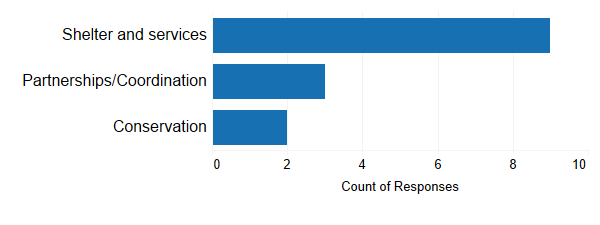
Other directors indicated that environmental conservation and artistic practices were linked. One director shared that their museum is “working with local Indigenous communities whose traditional culture practices (basket weaving, pottery making) are at risk because of climate change and the impact it is having on access to materials including clay and grasses.” This leader raises an opportunity for museums to become more connected to artist communities by maintaining an awareness and perhaps even stewardship of the materials used in local art-making practices.
Assessing Climate Impacts
While many art museum directors are taking on the responsibility of planning for the security of their buildings and collections, it is also important for them, as civic leaders, to understand their own impact on the environment. More than 70 percent of directors indicated their museum had begun to evaluate its climate impact in at least one way, higher than both the share of directors who said their museum had begun planning for climate change effects and the share of directors who said their museum had already experienced challenges or damage related to climate change (Figure 5). Sixty-four percent of directors shared that their museum has evaluated its climate impact with respect to building operations, and 18-23 percent of directors reported that they evaluate the impacts of traveling exhibitions, investments, or servers.
Figure 5: How Museums are Evaluating their Climate Impact
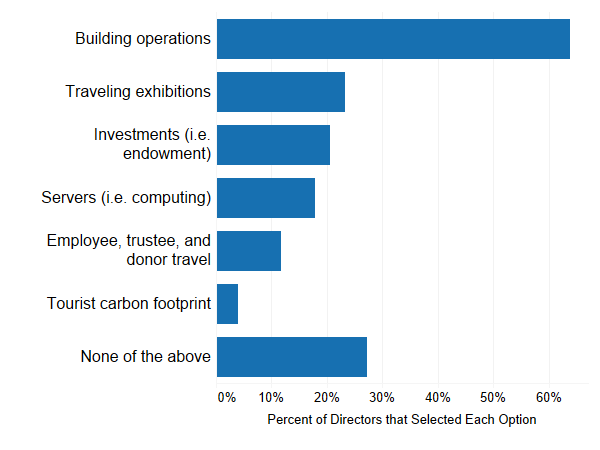
While the majority of directors indicated that their museum was already evaluating its climate impact in some way, many also reported facing barriers to doing so. Competing priorities and resources were most commonly cited as barriers to evaluating climate impact, but 18 percent of directors reported that they were simply unsure of where to begin. Our analysis revealed that the structure of the museum influences how this work is undertaken. Sixty-eight percent of academic museum directors said their museum had evaluated its climate impact in some form, compared to 77 percent of directors of municipal museums. Many free-text responses explained that this work was already being done or would need to take place at the college or university level. We only received one response out of all survey participants that indicated the director saw climate impact evaluations as unnecessary. Another director expressed concern that travel is more important to geographically remote museums, highlighting that one-size-fits-all approaches to climate impact reduction will not work across the field.
What’s Next
Our research shows that the art museum field is taking steps to address climate change both from the perspective of its impacts on collections, facilities, and staff and from the perspective of their own organization’s impact on the environment. The findings from this study can serve as a useful benchmark for change over time in the art museum field—for individual museums that want to measure themselves against their peers, and as a comparison point in the broader cultural heritage sector.
Museums are already spending considerable resources managing the effects of frequent and severe weather and disasters. Half of participating museums are planning for the effects of climate change and more than 70 percent of museums are evaluating their climate impacts. Further research is needed to gauge the effectiveness of these efforts in realizing sustainability goals, especially in the examples of museums that consider their community and equity goals in their strategies. At the same time, half of the art museums surveyed have no plans to address climate change disasters. Incorporating environmental sustainability and addressing climate change in organizational strategy will benefit from collaboration across the field.
Endnotes
- See AIC Board of Directors, “AIC Position Statement on Climate Change,” American Institute for Conservation, September 2019, https://www.culturalheritage.org/docs/default-source/resources/administration/governance/position-papers-and-statements/aic-positionstatement-climatechange_2019.pdf?sfvrsn=5f50820_14; and Elena Sesana, Alexandre S. Gagnon, Chiara Ciantelli, JoAnn Cassar, and John J. Hughes, “Climate Change Impacts on Cultural Heritage: A Literature Review,” WIREs Climate Change 12, no. 4 (2021): e710, https://doi.org/10.1002/wcc.710. ↑
-
Liam Sweeney, Joanna Dressel, “Art Museum Director Survey 2022: Documenting Change in Museum Strategy and Operations,” Ithaka S+R, 27 October 2022, https://doi.org/10.18665/sr.317777.
- Brian Boucher, “Dams, Floodgates, and Submarine Doors: Museums Are Spending Millions to Protect Their Art as Sea Levels Rise,” Artnet News, 31 August 31 2021, https://news.artnet.com/art-world/museums-flooding-climate-change-2004221. ↑
- Museo de Arte de Ponce, “Museo de Arte de Ponce Named Finalist for the IMLS National Medal for Museums and Libraries of 2021 – Museo de Arte de Ponce,” Accessed 1 March 2023, https://museoarteponce.org/en/museo-de-arte-de-ponce-named-finalist-for-2021-imls-national-medal-for-museum-and-library-service/. ↑